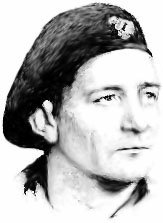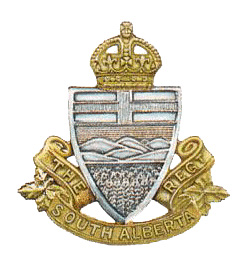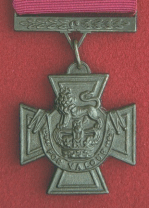
Try Amazon Fresh

Major D.V. Currie VC
The Lone Recipient of the Victoria Cross for the C.A.C. in the Second World War
![]()
| David Vivian Currie was
born in Sutherland, Saskatchewan on 08 July 1912. The
family lived in Moose Jaw Saskatchewan from 1913 to 1939
where he attended King George Public School and Central
Collegiate. Following his formal education, Currie
attended the Moose Jaw Technical School where he was
trained as an automobile mechanic and welder. Following service in the Militia, he joined the Canadian Army with the rank of lieutenant on 30 January 1940. He was promoted to Captain in April 1941 and was posted to the Royal Canadian Engineers training school at Dundern, Saskatchewan. A matter of months later, he was posted to the Canadian Armoured Corps training school at Camp Borden, Ontario. In May 1942 Currie joined the 29th Armoured Regiment (The South Alberta Regiment) which was a unit of 4th Canadian Armoured Division, and embarked for the United Kingdom in August 1942. The South Alberta Regiment was converted to 4th Canadian Armoured Division's armoured reconnaissance regiment in early 1943 and it landed in Normandy on 24 July 1944. Currie had been promoted to Major in March 1944, and commanded "C" Squadron of the South Albertas. |
 |
Following World War II, Currie spent eight years in Baie Comeau, Quebec as the maintenance superintendent for the Quebec North Shore Paper Company. In 1953 he moved to Montreal where he held management positions with Bonnar Equipment and National Harvester.
In 1959 Currie was appointed Sergeant-of-Arms of the House of Commons by Prime Minister John Diefenbaker. He held that position for seventeen years. Currie also served as vice-chairman of the Victoria Cross and George Cross Association (Overseas).
David Currie died on 20 June 1986 in Ottawa. He was buried in Owen Sound, Ontario, the home of his wife, the former Isabel Civil. A plaque to his memory was unveiled at Queen's Park in Owen Sound on 01 July 1989.

The Battle for St. Lambert-sur-Dives
Following the capture of Falaise in the Normandy fighting, 1st Canadian Army continued to push south towards American forces that were moving north, in a pincer effort to close the "Falaise Gap" to prevent the escape of an estimated five German panzer divisions. Montgomery issued orders to General Crerar of 1st Canadian Army demanding the immediate capture of the village of Trun and to continue moving further south to close the "Gap". Crerar in turn, passed these orders on to Lieutenant General Simmonds of 2nd Canadian Corps. Simmonds had anticipated this turn of events, and had already sent his forces in a drive towards Trun at all speed.
 |
On Friday, 18 August 1944, following the capture of Trun, the 29th Armoured Reconnaissance Regiment ( The South Alberta Regiment) was ordered to jump off from the village to occupy St. Lambert-sur-Dives and then advance further south to Moissy. All three squadrons of the regiment would take part in the forthcoming battle. The officer commanding the attack was Lt.-Col. Wotherspoon, the commanding officer of the SAR. Major Currie's task force was made up of the four troops of "C" Squadron of the SARs, plus the Squadron Headquarters. This gave him a total tank strength of nineteen Shermans. In addition to the tanks, he had "B" Company of the Argyll and Sutherland Highlanders of Canada which had a depleted strength of fifty-five men, and one troop of four SP 17-pdr M10s under his command. The M-10 tank destroyers would not remain with Currie as they would eventually marry up with the SAR Regimental Headquarters. Currie jumped off at 1800 hrs on the 18th of August with No.1 Troop of four tanks leading, followed by the three tanks and first aid vehicle of Squadron Headquarters, and then Nos. 2, 3 and 4 Troops which each had four tanks also. The infantry support rode the tanks and were to deploy in St. Lambert to consolidate the position. |
The lead Sherman came under fire almost immediately from the extreme left flank from what turned out to be the Polish Armoured Division. Currie corrected that problem and the advance continued. As the lead Troop entered St. Lambert the first Sherman was hit by 88mm fire and almost simultaneously, two roving Spitfires fired on the Squadron Headquarters tanks by mistake. Currie's Sherman was on fire as a result of the Spitfire attack and as he attempted to extinguish the flames, they made another strafing run, wounding several men, and causing Currie himself to leap into the roadside ditch for protection.
As it was getting dark, Currie conducted a reconnaissance on foot into the German occupied village to see if there was another way by which he could occupy the crossroads within the village where the 88mm fire had come from. Realizing that he couldn't flank the 88mm gun because of the Dives River which ran through the town, he returned to his Command and ordered the remaining three Shermans of No. 1 Troop to pull back two hundred yards to positions overlooking the village for the remainder of the night.
At dawn on Saturday morning, 19 August 1944, Currie's force began to fight its way into St. Lambert proper. The lead Sherman was again knocked out, but in doing so, the Germans had revealed the position of both a Panzer IV and Tiger. Currie's Command Sherman is credited with knocking out the Panzer IV, while infantry of the Argylls surprised and shot two of the Tiger crew. They then dropped a grenade down through the turret hatch killing the rest of the crew members, which effectively removed the Tiger as any further threat.
By mid-day of the 19th, Currie held approximately half of the village, but determined resistance prevented him from cutting the crossroads which the German troops desperately needed to keep open for their continued retreat. It was crucial that the Germans hold the line in St. Lambert to continue to allow the escape of their encicled troops. In the face of such determined resistance, Currie's advance stalled within the village and he dug in to hold what he had managed to gain. His tanks milled around firing their machine guns at each other to keep the Germans from climbing up on them. Currie was forced to call in an artillery barrage on his own position as the fighting intensified. The 4.5 inch artillery barrage saved the day by devastating the German troops. Currie consolidated his positions by withdrawing from parts of the village, and late in the day, he was able to resupply his tanks with ammunition from their supply column.
While Major Currie's task force was engaged in St. Lambert, Regimental Headquarters; together with the Reconnaissance Troop, Anti-Aircraft Troop and the troop of M-10 tank destroyers, was situated on Hill 117, which was located approximately 1000 yards north of the village. "A" Squadron was deployed along highway D13 that runs between Trun and St. Lambert. "B" Squadron, which would be overrun during the battle, was stationed on Hill 124, east of the village.
On the morning of Sunday, 20 August 1944, Currie and his men were caught up in more heavy fighting which continued periodically throughout the day. All of his officers, both armour and infantry, were put out of action due to wounds or fatalities. In the early evening the Germans began to concentrate for yet another attack. A Panzer IV and an 88mm ground gun were seen moving into a position about four hundred yards from the SAR headquarters. Currie opened fire using AP and HE rounds from eight of his tanks. The 88mm gun was destroyed and his tanks continued firing AP through several buildings behind which the German infantry were massing for an attack. Currie estimated that approximately one hundred rounds were fired which served to break up the attack before it could begin. Later that night a Panzer IV wandered into the Canadian positions and was knocked out by a shot to the engine compartment.
On Monday, 21 August 1944, Currie's force began taking large numbers of prisoners as it appeared that the German's enthusiasm for further battle was waning. By that evening, the situation in St. Lambert was well in hand and Currie was able to get some sleep for the first time in three days. On Tuesday, 22 August 1944, the SARs continued the advance and pursued the fleeing Germans towards the River Seine.

| The Citation for Major Currie's Victoria Cross |

|
Major Currie's original citation was for a Distinguished Service Order but the commanding officer of the SARs, Lt.-Col. Wotherspoon, changed it to a Victoria Cross on or about the 26 August 1944. The citation is reproduced in it's entirety below. While the SP M-10s are noted as being in Currie's task force, they in fact ended up with RHQ on Hill 117 and were not in the village of St. Lambert itself.
From the time he was awarded the Victoria Cross, Major Currie himself stressed the fact that any of the SAR squadrons could have done the same job he did in St. Lambert. He took pains to ensure that the battle in St. Lambert was viewed in it's proper context; that being as only a single part of the whole regimental battle.
| On 18th August 44 C
Squadron 29 Cdn. Regt. (SAR) with under command B company
A & S H of C and one troop 17 pounder self-propelled
antitank guns was ordered to advance to ST. LAMBERT SUR
DIVES to cut the CHAMBOIS TRUN escape route. Major D. V.
Currie was in command of this force, the strength of
which was 175 all ranks, 15 tanks and 4 self-propelled
anti-tank guns. By 2000 hrs. the armoured element of the force, moving in advance of the infantry, had reached the outskirts of the village where it was engaged by strong enemy forces. The two leading tanks had entered ST. LAMBERT but had been knocked out by 88 mm guns. Their crews were unable to get out of the village. Major Currie realized that only by immediate infantry attack could the village be captured that night, and, since the supporting infantry had not yet arrived, requested permission to dismount his squadron and attack the enemy position on foot. This request was not granted. At last light Major Currie was given permission to proceed into the village to reconnoitre the enemy defences and to extricate the crews of the disabled tanks. Although his approach route was under heavy mortar fire, he proceeded into the village on foot through enemy outposts, made his reconnaisance, personally directed the evacuation of the tank crews, remained until they were clear and then returned to his headquarters. On his return, the supporting infantry and anti-tank guns had arrived and Major Currie personally visited their positions to co-ordinate their defences and resite their weapons to cover all possible enemy approaches to his position. He then reported to his Commanding Officer and was ordered to attack the village at first light the following morning. At 0535 hrs. 19 Aug. ten minutes before the attack was to start, he was advised that the expected artillery support would not be available since the guns were out of range. Nevertheless Major Currie personally led the attack in the face of intense opposition by enemy armour, artillery, and infantry, and by noon succeeded in reaching a point approximately half-way into the village. Here, realising his attack was losing its impetus in the face of increasing enemy reinforcements, he decided to consolidate this position before proceeding further. He organized the position accordingly, and again made a tour of weapon pits, gun sites and tanks, encouraging the men by his calmness, his sound orders and his complete disregard for the numerical superiority of the enemy. The enemy promptly counter-attacked this position but so skilfully had Major Currie's defence been organised that the attack was repulsed with severe casualties to the enemy. During the following 36 hours a series of further counter-attacks increased in strength and ferocity throughout the period they were successively beaten off in very heavy fighting by the stubborn resistance of Major Currie's force. At dusk on 20 Aug., from the squadron position, enemy infantry could be seen massing for an attack which later proved to be the final effort on the enemy's part. Major Currie personally sited one troop of tanks to engage this force and directed their fire so effectively that the attack was never mounted. The destruction of this attacking force was the turning point in this action. During the morning of 21 Aug. 800 all ranks from this force alone surrendered; by noon the German morale was broken and Major Currie's force had completed the capture of the village. As a result the TRUN-CHAMBOIS escape route was completely denied to the remnant of two German armies. Throughout the three days' action Major Curries' conduct and self-sacrifice were a magnificent example to all ranks of the force under his command. On one occasion he personally directed the fire of his command tank onto a Tiger tank which had been harassing his position and succeeded in knocking it out. During another attack, while the guns of his command tank were taking on other targets at longer ranges, he used a rifle from the turret to deal with individual snipers who had infiltrated to within fifty yards of his headquarters. On the one occasion when reinforcements were able to get through to his force, he led the forty men forward into their positions and explained the importance of their task as a part of the defence. When, during the next attack, these new reinforcements withdrew under the intense fire brought down by the enemy, he personally collected them and led them forward into position again, where, inspired by his leadership they held for the remainder of the battle. His employment of his artillery support, which became available after his original attack went in, was typical of his cool calculation of the risks involved in every situation. At one time, despite the fact that short rounds were falling within fifteen yards of his own tank, he ordered fire from medium artillery to continue because of its devastating effect upon the attacking enemy in his immediate area. During this operation the casualties to Major Currie's force were very heavy. However, he never considered the possibility of failure or allowed it to enter the minds of his men. In the words of one of his non-commissioned officers. "We knew at one stage that it was going to be a fight to the finish but he was so cool about it, it was impossible for us to get excited." Since all the officers under his command were either killed or wounded during the action he had virtually no respite from his duties and in fact obtained only one hour's sleep during the entire period. Nevertheless he did not permit his fatigue to become apparent to his troops and throughout the action took every opportunity to visit weapon pits and other defensive posts to talk to his men, to advise them as to the best use of their weapons and to cheer them with words of encouragement. When his force was finally relieved and he was satisfied that the turnover was complete he fell asleep on his feet and collapsed. There can be no doubt that the success of this force's task on and stand against the enemy at ST. LAMBERT SUR DIVES can only be attributed to this officer's coolness, inspired leadership and skilful use of the limited weapons at his disposal. The courage and complete disregard for personal safety shown by Major Currie will forever be an inspiration to his regiment; his conspicuous bravery and extreme devotion to duty in the presence of the enemy an example to the Canadian Army for all time. |
(Major Currie's Victoria Cross is believed to still be in the care of his family.)

Site Map
© Chris Johnson, 1997-2002